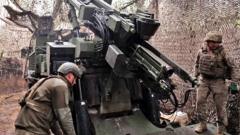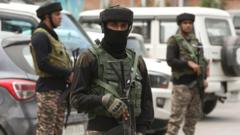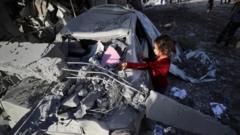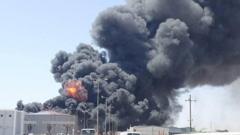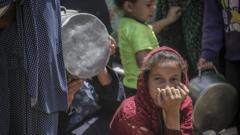Amid rising tensions and shelling along the Line of Control, the dangers faced by communities bordering India and Pakistan are laid bare, revealing the complexities of a long-standing conflict that continues to threaten lives on both sides.
**Brinkmanship at the India-Pakistan Border: A Looming Threat**
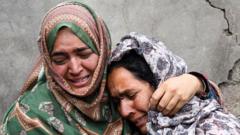
**Brinkmanship at the India-Pakistan Border: A Looming Threat**
As shells echo across the LoC, citizens are caught in a cycle of violence amidst fragile peace.
---
Living along the Line of Control (LoC), the volatile border dividing India and Pakistan, is akin to dancing on the edge of a knife—a precarious balance between fragile peace and the specter of war. The recent escalation in hostilities, triggered by the Pahalgam attack, has once again pushed both nations to the brink. The ensuing shelling has left devastation in its wake, claiming at least 16 lives on the Indian side, while Pakistan reports around 40 civilian casualties, though the exact number of deaths caused by the artillery fire remains uncertain.
Residents along the LoC face an existence marred by the unpredictable whims of both governments. Anam Zakaria, a Pakistani author residing in Canada, emphasized to the BBC that each resurgence of gunfire drives families into bunkers, resulting in the loss of livestock, livelihoods, and the destruction of essential infrastructure, including homes and schools, stating, "The vulnerability and volatility experienced has grave repercussions for their everyday lived reality."
The India-Pakistan border stretches over 3,323 km (2,064 miles), including the 740 km-long LoC that began as a ceasefire line after the first war in 1949 and was later rebranded under the 1972 Simla Agreement. This militarized boundary, particularly through Kashmir—territory claimed and administered by both nations—remains a flashpoint for conflict, with ceasefires only temporarily quelling tensions. Happymon Jacob, a policy expert, noted that ceasefire violations can range from minor exchanges of fire to major military operations, often executed to gain tactical advantages.
The LoC exemplifies borders forged in conflict, with local dynamics and military imperatives dictating actions often independent of high-level political oversight. In a historical context, Sumantra Bose points to other examples of conflict-driven borders in the world, such as the 'Green Line' in the Israel-Palestine dispute, illustrating that this phenomenon is not confined to South Asia.
As the latest flare-up deteriorates the relatively stable period observed since the 2021 ceasefire, experts are observing closely. Surya Valliappan Krishna from Carnegie India noted the significance of this escalation following a long stretch of peace. Historical data reveals that prior to the 2003 ceasefire, India noted thousands of ceasefire violations yearly, exemplifying the ongoing volatility along the border.
Recent developments have brought additional complications. Following the Pahalgam incident, India suspended the crucial Indus Waters Treaty, which governs water-sharing between the two countries; Pakistan, in response, has threatened to revoke the Simla Agreement. Such movements have profound implications for the already shaky equilibrium along the LoC.
Some experts suggest revisiting the idea of formalizing the LoC into an officially recognized border. However, this proposition is contentious, with many viewing it as an unrealistic prospect. As Bose articulates, for India, the region remains tightly bound to its national identity, while for Pakistan, adjusting the LoC status would equate to conceding claims to the territory—an unthinkable outcome for successive Pakistani administrations.
Amid this growing turmoil, local voices underscore the impact of ongoing violence. A hotel employee in Pakistan-administered Kashmir reflected the overwhelming sense of dread: "You never know what will happen next. No one wants to sleep facing the Line of Control tonight." This sentiment encapsulates the precariousness faced by those living in the shadow of war, reminding all of the fragile nature of peace along one of the world's most dangerous borders.
Living along the Line of Control (LoC), the volatile border dividing India and Pakistan, is akin to dancing on the edge of a knife—a precarious balance between fragile peace and the specter of war. The recent escalation in hostilities, triggered by the Pahalgam attack, has once again pushed both nations to the brink. The ensuing shelling has left devastation in its wake, claiming at least 16 lives on the Indian side, while Pakistan reports around 40 civilian casualties, though the exact number of deaths caused by the artillery fire remains uncertain.
Residents along the LoC face an existence marred by the unpredictable whims of both governments. Anam Zakaria, a Pakistani author residing in Canada, emphasized to the BBC that each resurgence of gunfire drives families into bunkers, resulting in the loss of livestock, livelihoods, and the destruction of essential infrastructure, including homes and schools, stating, "The vulnerability and volatility experienced has grave repercussions for their everyday lived reality."
The India-Pakistan border stretches over 3,323 km (2,064 miles), including the 740 km-long LoC that began as a ceasefire line after the first war in 1949 and was later rebranded under the 1972 Simla Agreement. This militarized boundary, particularly through Kashmir—territory claimed and administered by both nations—remains a flashpoint for conflict, with ceasefires only temporarily quelling tensions. Happymon Jacob, a policy expert, noted that ceasefire violations can range from minor exchanges of fire to major military operations, often executed to gain tactical advantages.
The LoC exemplifies borders forged in conflict, with local dynamics and military imperatives dictating actions often independent of high-level political oversight. In a historical context, Sumantra Bose points to other examples of conflict-driven borders in the world, such as the 'Green Line' in the Israel-Palestine dispute, illustrating that this phenomenon is not confined to South Asia.
As the latest flare-up deteriorates the relatively stable period observed since the 2021 ceasefire, experts are observing closely. Surya Valliappan Krishna from Carnegie India noted the significance of this escalation following a long stretch of peace. Historical data reveals that prior to the 2003 ceasefire, India noted thousands of ceasefire violations yearly, exemplifying the ongoing volatility along the border.
Recent developments have brought additional complications. Following the Pahalgam incident, India suspended the crucial Indus Waters Treaty, which governs water-sharing between the two countries; Pakistan, in response, has threatened to revoke the Simla Agreement. Such movements have profound implications for the already shaky equilibrium along the LoC.
Some experts suggest revisiting the idea of formalizing the LoC into an officially recognized border. However, this proposition is contentious, with many viewing it as an unrealistic prospect. As Bose articulates, for India, the region remains tightly bound to its national identity, while for Pakistan, adjusting the LoC status would equate to conceding claims to the territory—an unthinkable outcome for successive Pakistani administrations.
Amid this growing turmoil, local voices underscore the impact of ongoing violence. A hotel employee in Pakistan-administered Kashmir reflected the overwhelming sense of dread: "You never know what will happen next. No one wants to sleep facing the Line of Control tonight." This sentiment encapsulates the precariousness faced by those living in the shadow of war, reminding all of the fragile nature of peace along one of the world's most dangerous borders.




